Tesla in India: Entry Modes, Competitive Advantage & Challenges
VerifiedAdded on 2023/06/09
|12
|2522
|320
Report
AI Summary
This report provides a detailed analysis of Tesla's international business strategy, focusing on its potential entry into the Indian market. It examines various factors influencing Tesla's decision, including India's import policies, local sourcing requirements, and evolving electric vehicle infrastructure. The report explores potential entry modes, suggesting a joint venture as a strategic option. Furthermore, it assesses Tesla's sustainable competitive advantage in India using Porter's Diamond model, considering demand factors, factor conditions, related industries, and the role of the Indian government as a catalyst. The report also discusses the effects of internationalization and foreign direct investment on the Indian economy, including potential benefits like increased dollar inflow, job creation, and technological advancement, highlighting both challenges and opportunities for Tesla in the Indian market. Desklib provides a platform for students to access similar past papers and solved assignments.
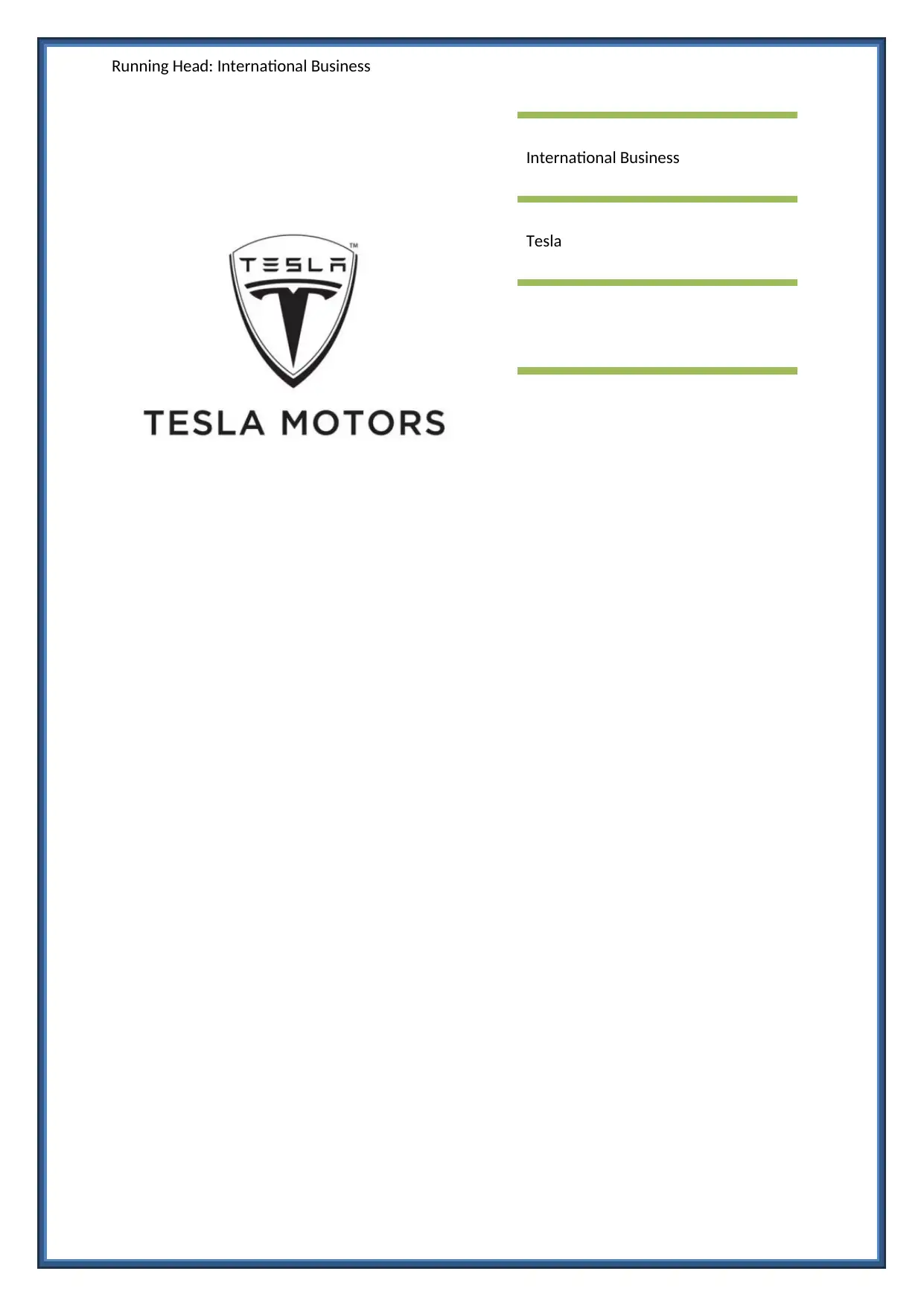
Running Head: International Business
International Business
Tesla
International Business
Tesla
Paraphrase This Document
Need a fresh take? Get an instant paraphrase of this document with our AI Paraphraser
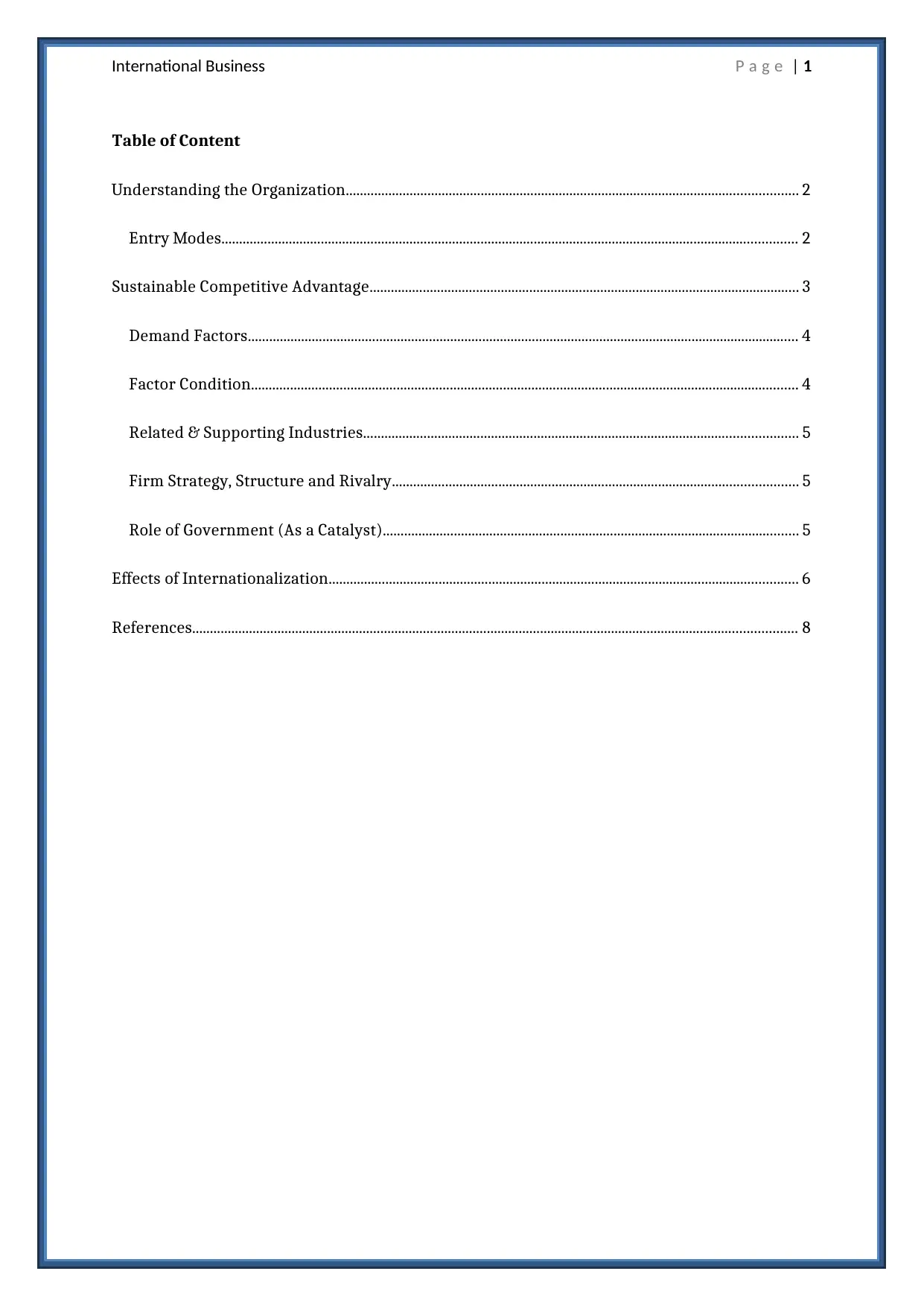
International Business P a g e | 1
Table of Content
Understanding the Organization............................................................................................................................... 2
Entry Modes.................................................................................................................................................................. 2
Sustainable Competitive Advantage......................................................................................................................... 3
Demand Factors........................................................................................................................................................... 4
Factor Condition.......................................................................................................................................................... 4
Related & Supporting Industries.......................................................................................................................... 5
Firm Strategy, Structure and Rivalry.................................................................................................................. 5
Role of Government (As a Catalyst)..................................................................................................................... 5
Effects of Internationalization.................................................................................................................................... 6
References.......................................................................................................................................................................... 8
Table of Content
Understanding the Organization............................................................................................................................... 2
Entry Modes.................................................................................................................................................................. 2
Sustainable Competitive Advantage......................................................................................................................... 3
Demand Factors........................................................................................................................................................... 4
Factor Condition.......................................................................................................................................................... 4
Related & Supporting Industries.......................................................................................................................... 5
Firm Strategy, Structure and Rivalry.................................................................................................................. 5
Role of Government (As a Catalyst)..................................................................................................................... 5
Effects of Internationalization.................................................................................................................................... 6
References.......................................................................................................................................................................... 8
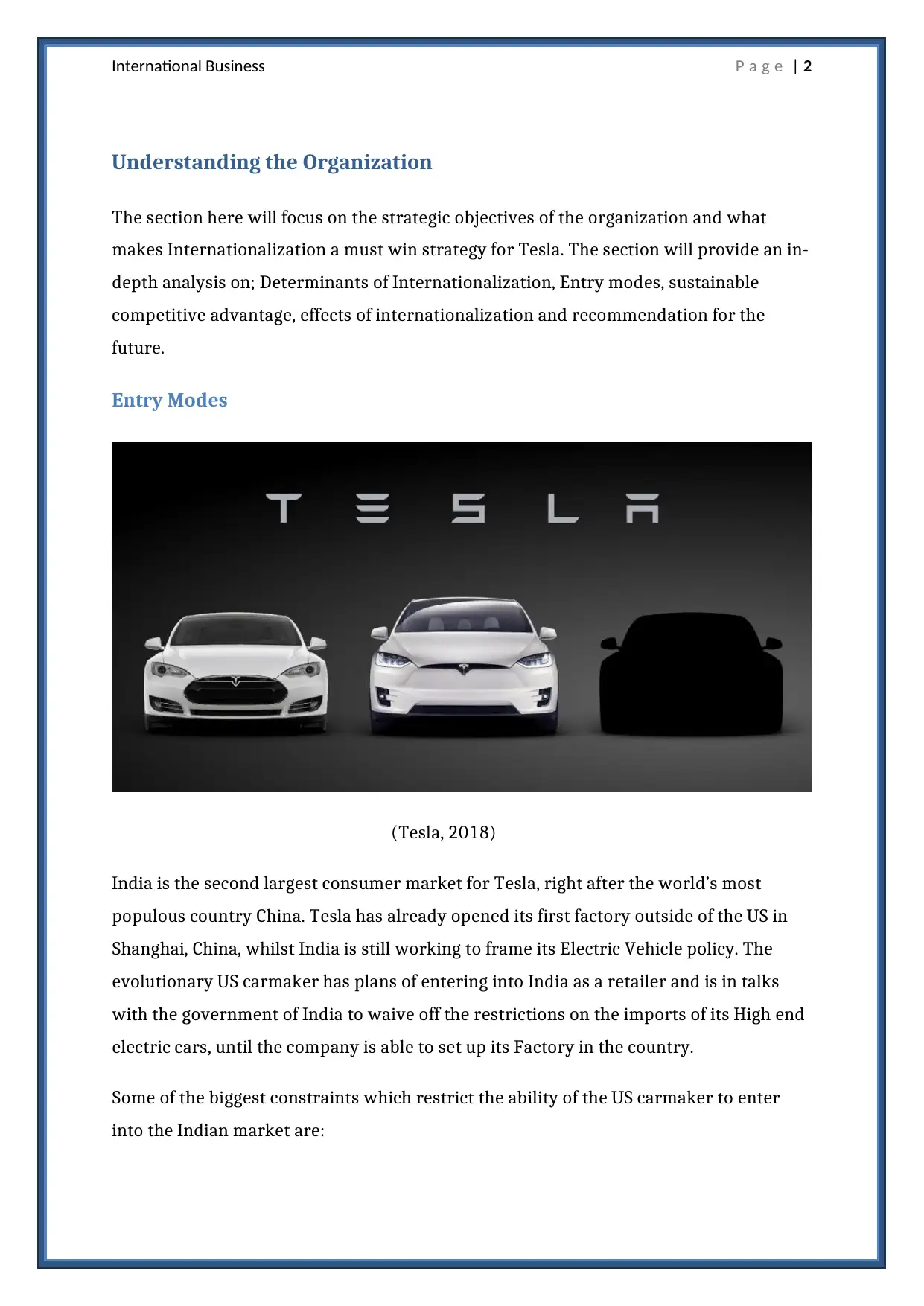
International Business P a g e | 2
Understanding the Organization
The section here will focus on the strategic objectives of the organization and what
makes Internationalization a must win strategy for Tesla. The section will provide an in-
depth analysis on; Determinants of Internationalization, Entry modes, sustainable
competitive advantage, effects of internationalization and recommendation for the
future.
Entry Modes
(Tesla, 2018)
India is the second largest consumer market for Tesla, right after the world’s most
populous country China. Tesla has already opened its first factory outside of the US in
Shanghai, China, whilst India is still working to frame its Electric Vehicle policy. The
evolutionary US carmaker has plans of entering into India as a retailer and is in talks
with the government of India to waive off the restrictions on the imports of its High end
electric cars, until the company is able to set up its Factory in the country.
Some of the biggest constraints which restrict the ability of the US carmaker to enter
into the Indian market are:
Understanding the Organization
The section here will focus on the strategic objectives of the organization and what
makes Internationalization a must win strategy for Tesla. The section will provide an in-
depth analysis on; Determinants of Internationalization, Entry modes, sustainable
competitive advantage, effects of internationalization and recommendation for the
future.
Entry Modes
(Tesla, 2018)
India is the second largest consumer market for Tesla, right after the world’s most
populous country China. Tesla has already opened its first factory outside of the US in
Shanghai, China, whilst India is still working to frame its Electric Vehicle policy. The
evolutionary US carmaker has plans of entering into India as a retailer and is in talks
with the government of India to waive off the restrictions on the imports of its High end
electric cars, until the company is able to set up its Factory in the country.
Some of the biggest constraints which restrict the ability of the US carmaker to enter
into the Indian market are:
⊘ This is a preview!⊘
Do you want full access?
Subscribe today to unlock all pages.

Trusted by 1+ million students worldwide
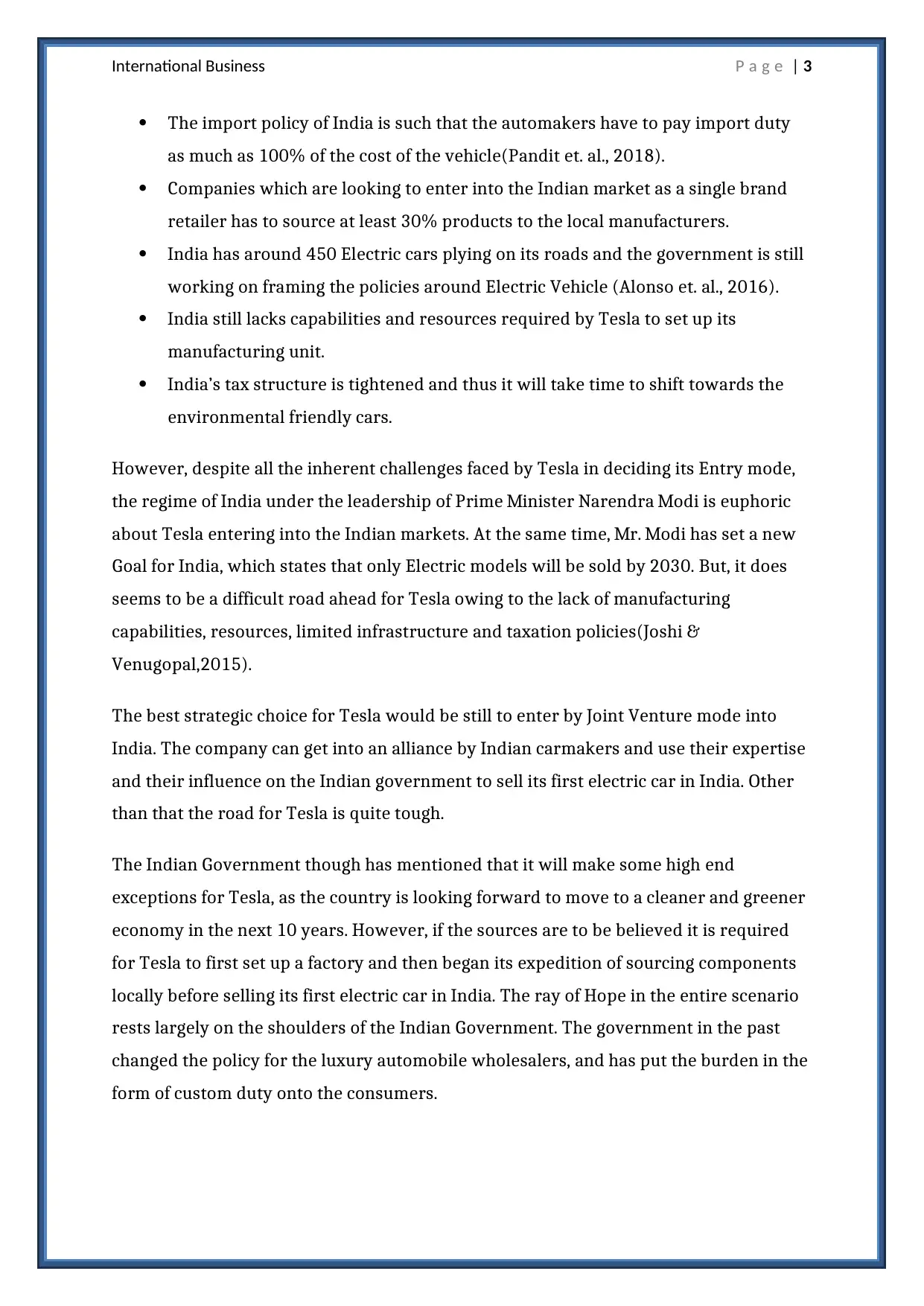
International Business P a g e | 3
The import policy of India is such that the automakers have to pay import duty
as much as 100% of the cost of the vehicle(Pandit et. al., 2018).
Companies which are looking to enter into the Indian market as a single brand
retailer has to source at least 30% products to the local manufacturers.
India has around 450 Electric cars plying on its roads and the government is still
working on framing the policies around Electric Vehicle (Alonso et. al., 2016).
India still lacks capabilities and resources required by Tesla to set up its
manufacturing unit.
India’s tax structure is tightened and thus it will take time to shift towards the
environmental friendly cars.
However, despite all the inherent challenges faced by Tesla in deciding its Entry mode,
the regime of India under the leadership of Prime Minister Narendra Modi is euphoric
about Tesla entering into the Indian markets. At the same time, Mr. Modi has set a new
Goal for India, which states that only Electric models will be sold by 2030. But, it does
seems to be a difficult road ahead for Tesla owing to the lack of manufacturing
capabilities, resources, limited infrastructure and taxation policies(Joshi &
Venugopal,2015).
The best strategic choice for Tesla would be still to enter by Joint Venture mode into
India. The company can get into an alliance by Indian carmakers and use their expertise
and their influence on the Indian government to sell its first electric car in India. Other
than that the road for Tesla is quite tough.
The Indian Government though has mentioned that it will make some high end
exceptions for Tesla, as the country is looking forward to move to a cleaner and greener
economy in the next 10 years. However, if the sources are to be believed it is required
for Tesla to first set up a factory and then began its expedition of sourcing components
locally before selling its first electric car in India. The ray of Hope in the entire scenario
rests largely on the shoulders of the Indian Government. The government in the past
changed the policy for the luxury automobile wholesalers, and has put the burden in the
form of custom duty onto the consumers.
The import policy of India is such that the automakers have to pay import duty
as much as 100% of the cost of the vehicle(Pandit et. al., 2018).
Companies which are looking to enter into the Indian market as a single brand
retailer has to source at least 30% products to the local manufacturers.
India has around 450 Electric cars plying on its roads and the government is still
working on framing the policies around Electric Vehicle (Alonso et. al., 2016).
India still lacks capabilities and resources required by Tesla to set up its
manufacturing unit.
India’s tax structure is tightened and thus it will take time to shift towards the
environmental friendly cars.
However, despite all the inherent challenges faced by Tesla in deciding its Entry mode,
the regime of India under the leadership of Prime Minister Narendra Modi is euphoric
about Tesla entering into the Indian markets. At the same time, Mr. Modi has set a new
Goal for India, which states that only Electric models will be sold by 2030. But, it does
seems to be a difficult road ahead for Tesla owing to the lack of manufacturing
capabilities, resources, limited infrastructure and taxation policies(Joshi &
Venugopal,2015).
The best strategic choice for Tesla would be still to enter by Joint Venture mode into
India. The company can get into an alliance by Indian carmakers and use their expertise
and their influence on the Indian government to sell its first electric car in India. Other
than that the road for Tesla is quite tough.
The Indian Government though has mentioned that it will make some high end
exceptions for Tesla, as the country is looking forward to move to a cleaner and greener
economy in the next 10 years. However, if the sources are to be believed it is required
for Tesla to first set up a factory and then began its expedition of sourcing components
locally before selling its first electric car in India. The ray of Hope in the entire scenario
rests largely on the shoulders of the Indian Government. The government in the past
changed the policy for the luxury automobile wholesalers, and has put the burden in the
form of custom duty onto the consumers.
Paraphrase This Document
Need a fresh take? Get an instant paraphrase of this document with our AI Paraphraser
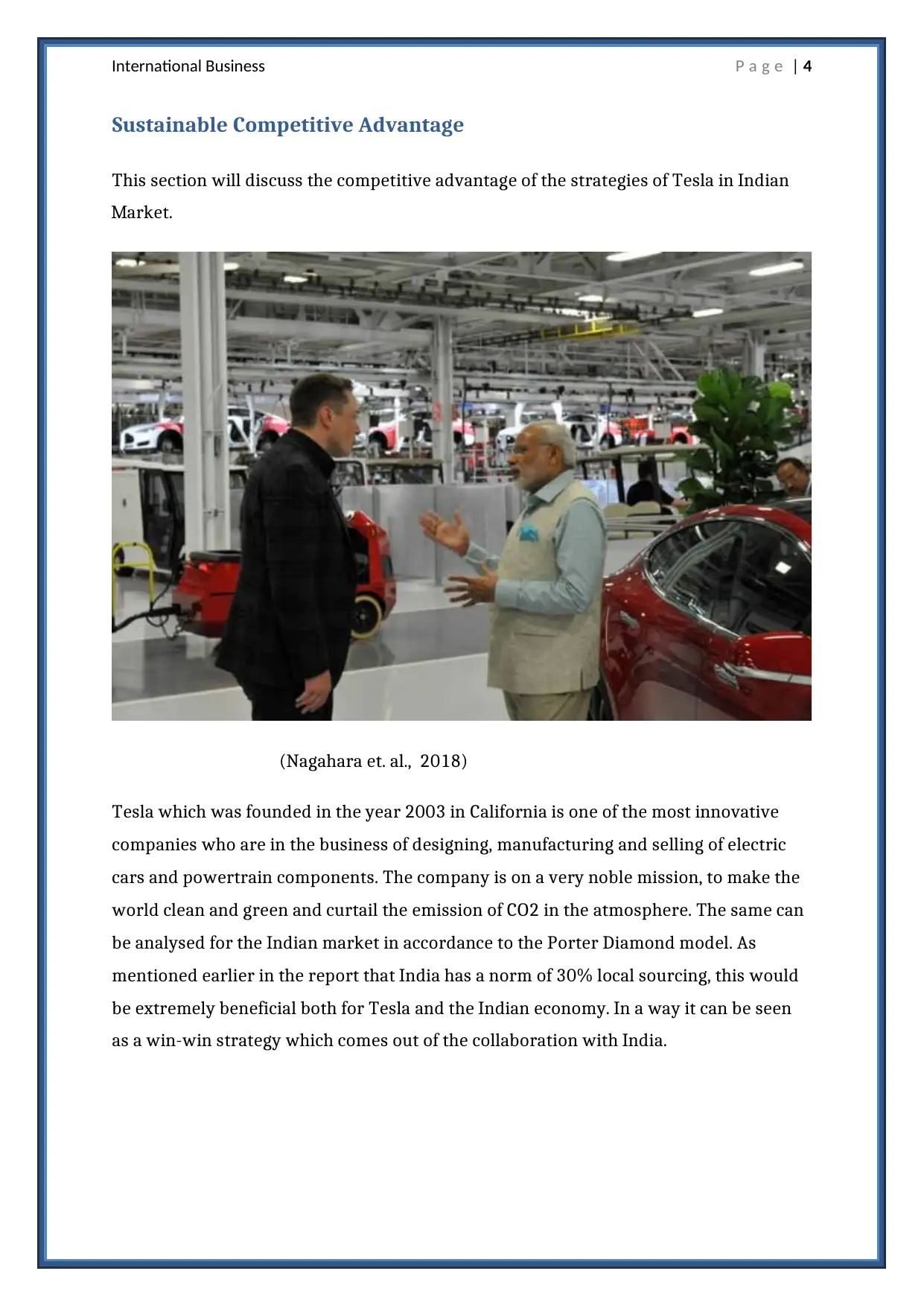
International Business P a g e | 4
Sustainable Competitive Advantage
This section will discuss the competitive advantage of the strategies of Tesla in Indian
Market.
(Nagahara et. al., 2018)
Tesla which was founded in the year 2003 in California is one of the most innovative
companies who are in the business of designing, manufacturing and selling of electric
cars and powertrain components. The company is on a very noble mission, to make the
world clean and green and curtail the emission of CO2 in the atmosphere. The same can
be analysed for the Indian market in accordance to the Porter Diamond model. As
mentioned earlier in the report that India has a norm of 30% local sourcing, this would
be extremely beneficial both for Tesla and the Indian economy. In a way it can be seen
as a win-win strategy which comes out of the collaboration with India.
Sustainable Competitive Advantage
This section will discuss the competitive advantage of the strategies of Tesla in Indian
Market.
(Nagahara et. al., 2018)
Tesla which was founded in the year 2003 in California is one of the most innovative
companies who are in the business of designing, manufacturing and selling of electric
cars and powertrain components. The company is on a very noble mission, to make the
world clean and green and curtail the emission of CO2 in the atmosphere. The same can
be analysed for the Indian market in accordance to the Porter Diamond model. As
mentioned earlier in the report that India has a norm of 30% local sourcing, this would
be extremely beneficial both for Tesla and the Indian economy. In a way it can be seen
as a win-win strategy which comes out of the collaboration with India.
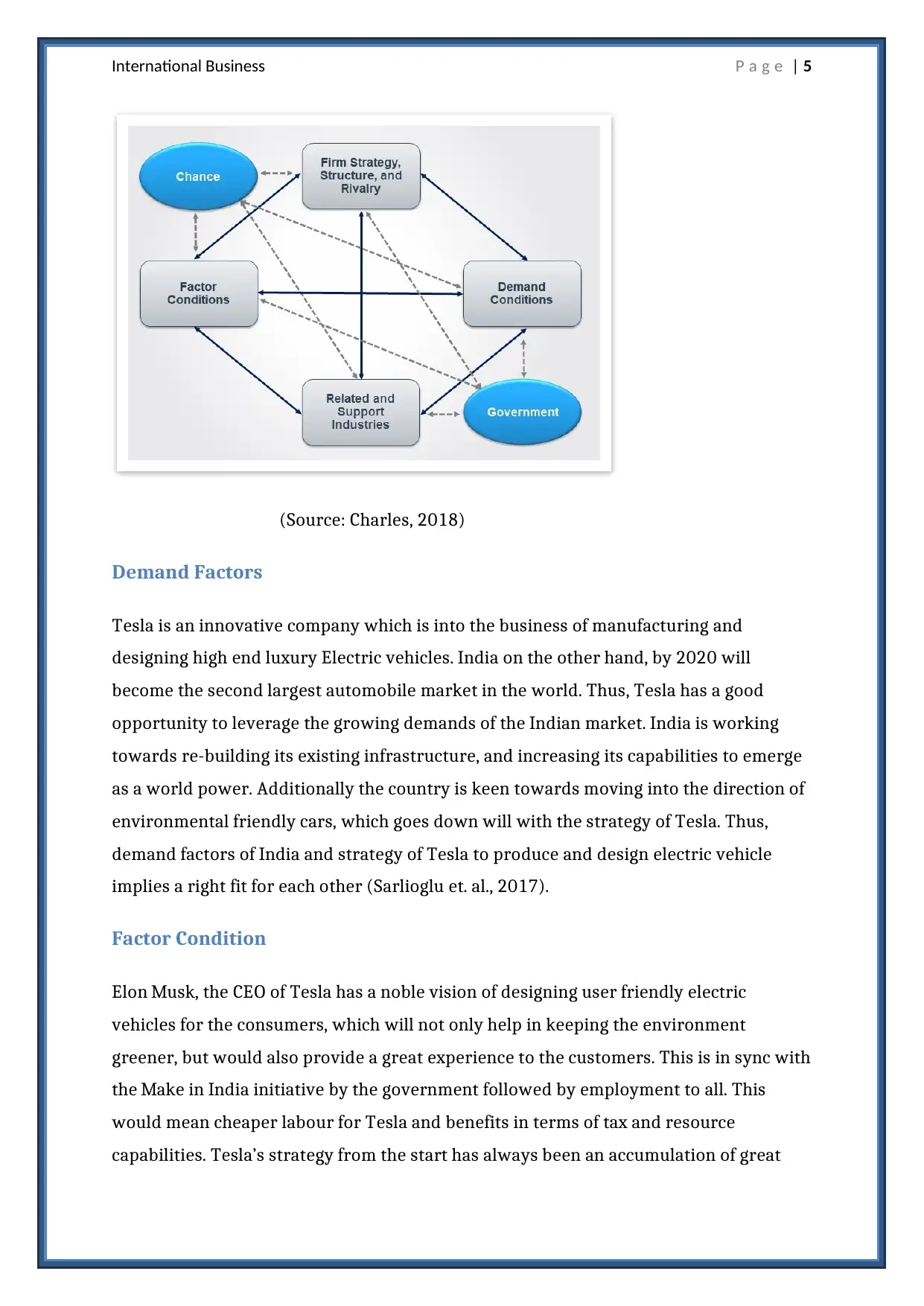
International Business P a g e | 5
(Source: Charles, 2018)
Demand Factors
Tesla is an innovative company which is into the business of manufacturing and
designing high end luxury Electric vehicles. India on the other hand, by 2020 will
become the second largest automobile market in the world. Thus, Tesla has a good
opportunity to leverage the growing demands of the Indian market. India is working
towards re-building its existing infrastructure, and increasing its capabilities to emerge
as a world power. Additionally the country is keen towards moving into the direction of
environmental friendly cars, which goes down will with the strategy of Tesla. Thus,
demand factors of India and strategy of Tesla to produce and design electric vehicle
implies a right fit for each other (Sarlioglu et. al., 2017).
Factor Condition
Elon Musk, the CEO of Tesla has a noble vision of designing user friendly electric
vehicles for the consumers, which will not only help in keeping the environment
greener, but would also provide a great experience to the customers. This is in sync with
the Make in India initiative by the government followed by employment to all. This
would mean cheaper labour for Tesla and benefits in terms of tax and resource
capabilities. Tesla’s strategy from the start has always been an accumulation of great
(Source: Charles, 2018)
Demand Factors
Tesla is an innovative company which is into the business of manufacturing and
designing high end luxury Electric vehicles. India on the other hand, by 2020 will
become the second largest automobile market in the world. Thus, Tesla has a good
opportunity to leverage the growing demands of the Indian market. India is working
towards re-building its existing infrastructure, and increasing its capabilities to emerge
as a world power. Additionally the country is keen towards moving into the direction of
environmental friendly cars, which goes down will with the strategy of Tesla. Thus,
demand factors of India and strategy of Tesla to produce and design electric vehicle
implies a right fit for each other (Sarlioglu et. al., 2017).
Factor Condition
Elon Musk, the CEO of Tesla has a noble vision of designing user friendly electric
vehicles for the consumers, which will not only help in keeping the environment
greener, but would also provide a great experience to the customers. This is in sync with
the Make in India initiative by the government followed by employment to all. This
would mean cheaper labour for Tesla and benefits in terms of tax and resource
capabilities. Tesla’s strategy from the start has always been an accumulation of great
⊘ This is a preview!⊘
Do you want full access?
Subscribe today to unlock all pages.

Trusted by 1+ million students worldwide
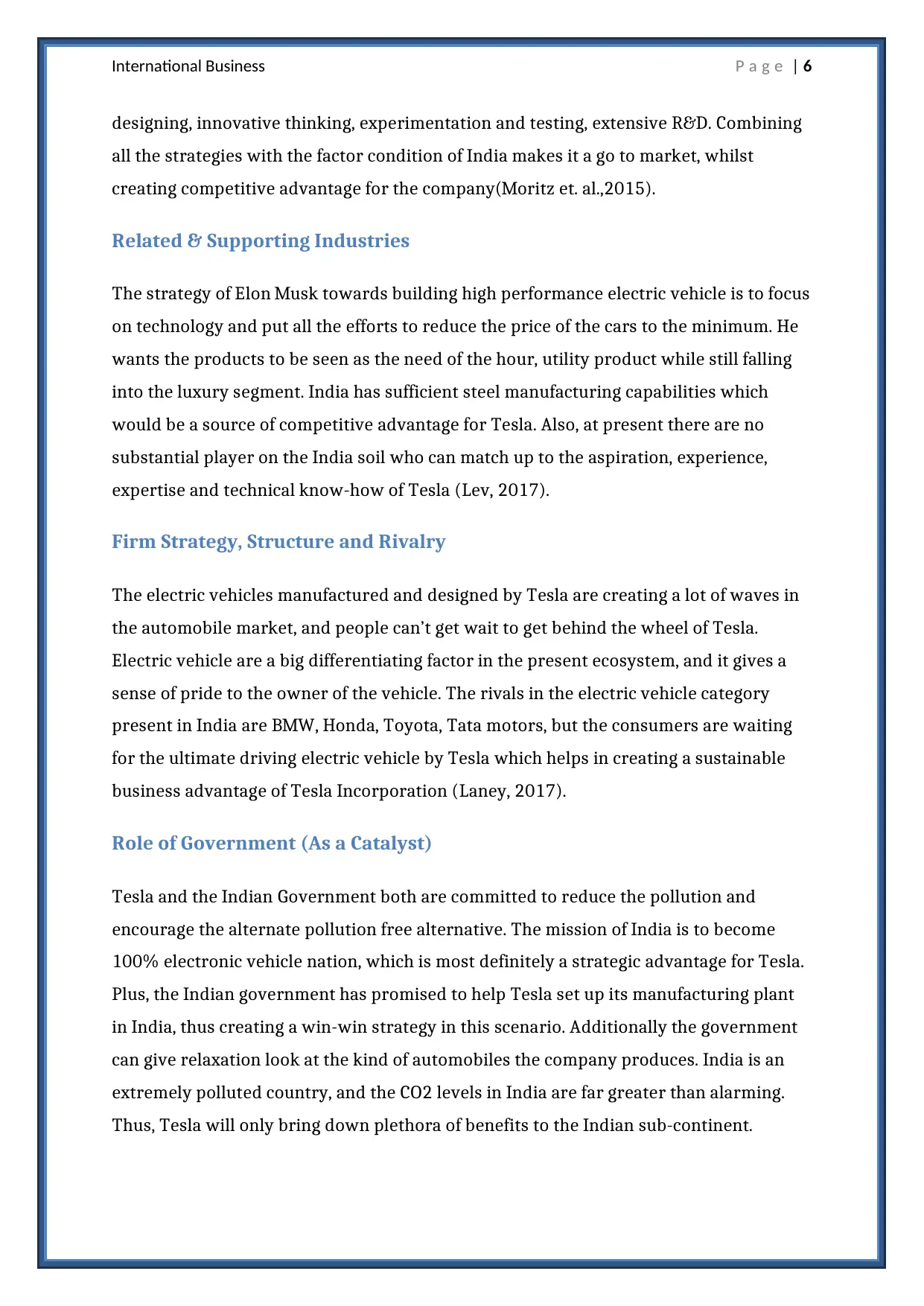
International Business P a g e | 6
designing, innovative thinking, experimentation and testing, extensive R&D. Combining
all the strategies with the factor condition of India makes it a go to market, whilst
creating competitive advantage for the company(Moritz et. al.,2015).
Related & Supporting Industries
The strategy of Elon Musk towards building high performance electric vehicle is to focus
on technology and put all the efforts to reduce the price of the cars to the minimum. He
wants the products to be seen as the need of the hour, utility product while still falling
into the luxury segment. India has sufficient steel manufacturing capabilities which
would be a source of competitive advantage for Tesla. Also, at present there are no
substantial player on the India soil who can match up to the aspiration, experience,
expertise and technical know-how of Tesla (Lev, 2017).
Firm Strategy, Structure and Rivalry
The electric vehicles manufactured and designed by Tesla are creating a lot of waves in
the automobile market, and people can’t get wait to get behind the wheel of Tesla.
Electric vehicle are a big differentiating factor in the present ecosystem, and it gives a
sense of pride to the owner of the vehicle. The rivals in the electric vehicle category
present in India are BMW, Honda, Toyota, Tata motors, but the consumers are waiting
for the ultimate driving electric vehicle by Tesla which helps in creating a sustainable
business advantage of Tesla Incorporation (Laney, 2017).
Role of Government (As a Catalyst)
Tesla and the Indian Government both are committed to reduce the pollution and
encourage the alternate pollution free alternative. The mission of India is to become
100% electronic vehicle nation, which is most definitely a strategic advantage for Tesla.
Plus, the Indian government has promised to help Tesla set up its manufacturing plant
in India, thus creating a win-win strategy in this scenario. Additionally the government
can give relaxation look at the kind of automobiles the company produces. India is an
extremely polluted country, and the CO2 levels in India are far greater than alarming.
Thus, Tesla will only bring down plethora of benefits to the Indian sub-continent.
designing, innovative thinking, experimentation and testing, extensive R&D. Combining
all the strategies with the factor condition of India makes it a go to market, whilst
creating competitive advantage for the company(Moritz et. al.,2015).
Related & Supporting Industries
The strategy of Elon Musk towards building high performance electric vehicle is to focus
on technology and put all the efforts to reduce the price of the cars to the minimum. He
wants the products to be seen as the need of the hour, utility product while still falling
into the luxury segment. India has sufficient steel manufacturing capabilities which
would be a source of competitive advantage for Tesla. Also, at present there are no
substantial player on the India soil who can match up to the aspiration, experience,
expertise and technical know-how of Tesla (Lev, 2017).
Firm Strategy, Structure and Rivalry
The electric vehicles manufactured and designed by Tesla are creating a lot of waves in
the automobile market, and people can’t get wait to get behind the wheel of Tesla.
Electric vehicle are a big differentiating factor in the present ecosystem, and it gives a
sense of pride to the owner of the vehicle. The rivals in the electric vehicle category
present in India are BMW, Honda, Toyota, Tata motors, but the consumers are waiting
for the ultimate driving electric vehicle by Tesla which helps in creating a sustainable
business advantage of Tesla Incorporation (Laney, 2017).
Role of Government (As a Catalyst)
Tesla and the Indian Government both are committed to reduce the pollution and
encourage the alternate pollution free alternative. The mission of India is to become
100% electronic vehicle nation, which is most definitely a strategic advantage for Tesla.
Plus, the Indian government has promised to help Tesla set up its manufacturing plant
in India, thus creating a win-win strategy in this scenario. Additionally the government
can give relaxation look at the kind of automobiles the company produces. India is an
extremely polluted country, and the CO2 levels in India are far greater than alarming.
Thus, Tesla will only bring down plethora of benefits to the Indian sub-continent.
Paraphrase This Document
Need a fresh take? Get an instant paraphrase of this document with our AI Paraphraser
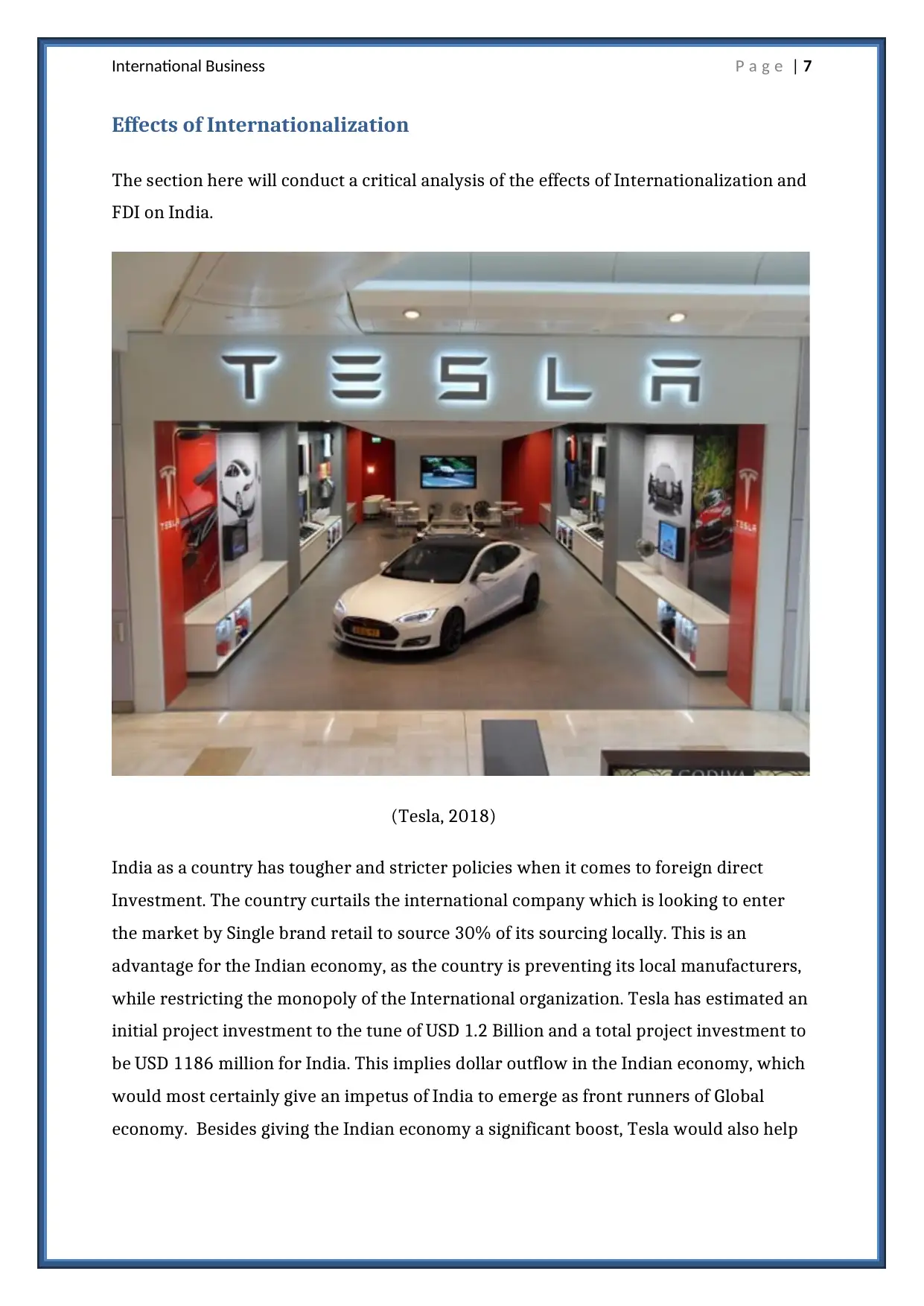
International Business P a g e | 7
Effects of Internationalization
The section here will conduct a critical analysis of the effects of Internationalization and
FDI on India.
(Tesla, 2018)
India as a country has tougher and stricter policies when it comes to foreign direct
Investment. The country curtails the international company which is looking to enter
the market by Single brand retail to source 30% of its sourcing locally. This is an
advantage for the Indian economy, as the country is preventing its local manufacturers,
while restricting the monopoly of the International organization. Tesla has estimated an
initial project investment to the tune of USD 1.2 Billion and a total project investment to
be USD 1186 million for India. This implies dollar outflow in the Indian economy, which
would most certainly give an impetus of India to emerge as front runners of Global
economy. Besides giving the Indian economy a significant boost, Tesla would also help
Effects of Internationalization
The section here will conduct a critical analysis of the effects of Internationalization and
FDI on India.
(Tesla, 2018)
India as a country has tougher and stricter policies when it comes to foreign direct
Investment. The country curtails the international company which is looking to enter
the market by Single brand retail to source 30% of its sourcing locally. This is an
advantage for the Indian economy, as the country is preventing its local manufacturers,
while restricting the monopoly of the International organization. Tesla has estimated an
initial project investment to the tune of USD 1.2 Billion and a total project investment to
be USD 1186 million for India. This implies dollar outflow in the Indian economy, which
would most certainly give an impetus of India to emerge as front runners of Global
economy. Besides giving the Indian economy a significant boost, Tesla would also help
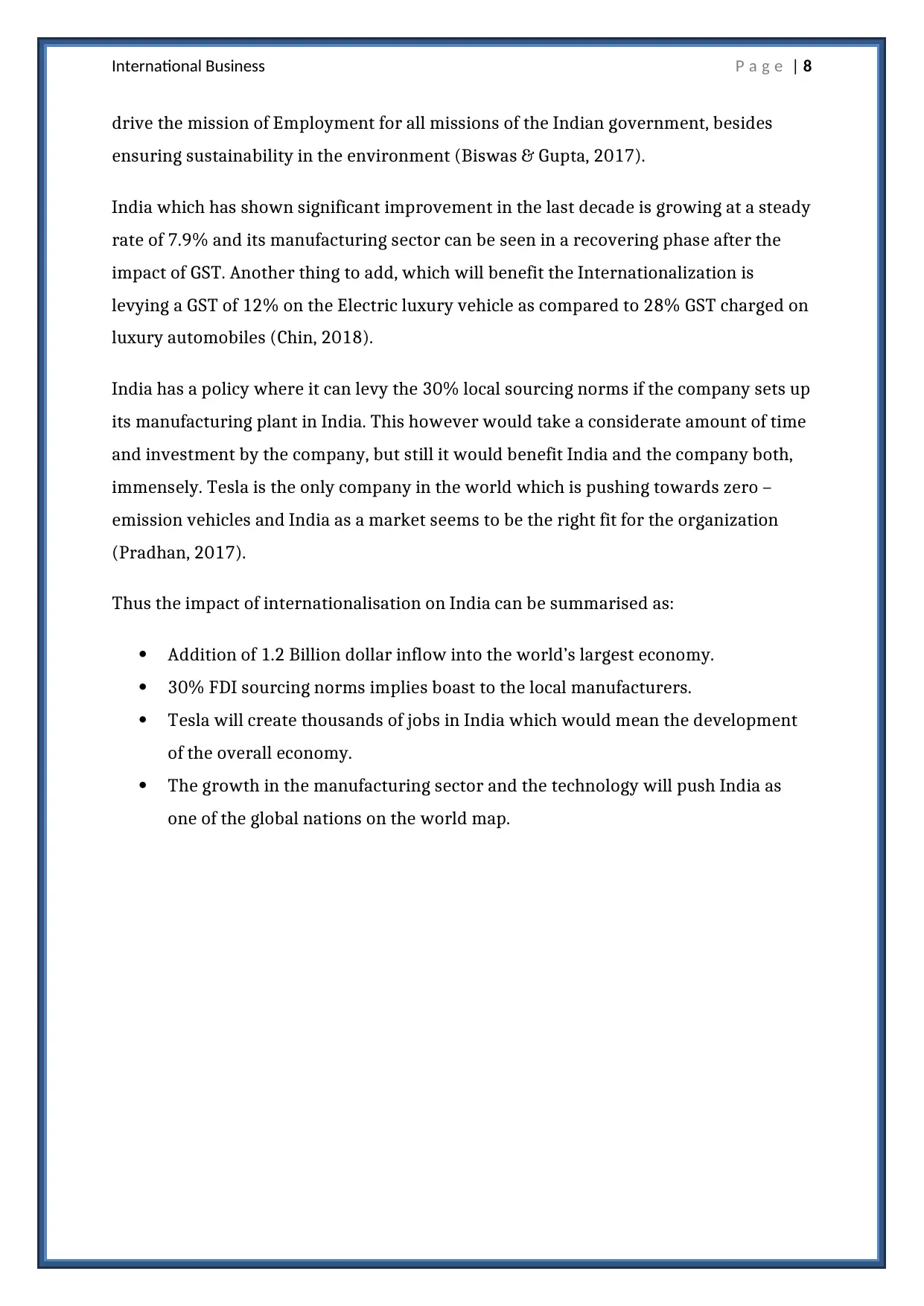
International Business P a g e | 8
drive the mission of Employment for all missions of the Indian government, besides
ensuring sustainability in the environment (Biswas & Gupta, 2017).
India which has shown significant improvement in the last decade is growing at a steady
rate of 7.9% and its manufacturing sector can be seen in a recovering phase after the
impact of GST. Another thing to add, which will benefit the Internationalization is
levying a GST of 12% on the Electric luxury vehicle as compared to 28% GST charged on
luxury automobiles (Chin, 2018).
India has a policy where it can levy the 30% local sourcing norms if the company sets up
its manufacturing plant in India. This however would take a considerate amount of time
and investment by the company, but still it would benefit India and the company both,
immensely. Tesla is the only company in the world which is pushing towards zero –
emission vehicles and India as a market seems to be the right fit for the organization
(Pradhan, 2017).
Thus the impact of internationalisation on India can be summarised as:
Addition of 1.2 Billion dollar inflow into the world’s largest economy.
30% FDI sourcing norms implies boast to the local manufacturers.
Tesla will create thousands of jobs in India which would mean the development
of the overall economy.
The growth in the manufacturing sector and the technology will push India as
one of the global nations on the world map.
drive the mission of Employment for all missions of the Indian government, besides
ensuring sustainability in the environment (Biswas & Gupta, 2017).
India which has shown significant improvement in the last decade is growing at a steady
rate of 7.9% and its manufacturing sector can be seen in a recovering phase after the
impact of GST. Another thing to add, which will benefit the Internationalization is
levying a GST of 12% on the Electric luxury vehicle as compared to 28% GST charged on
luxury automobiles (Chin, 2018).
India has a policy where it can levy the 30% local sourcing norms if the company sets up
its manufacturing plant in India. This however would take a considerate amount of time
and investment by the company, but still it would benefit India and the company both,
immensely. Tesla is the only company in the world which is pushing towards zero –
emission vehicles and India as a market seems to be the right fit for the organization
(Pradhan, 2017).
Thus the impact of internationalisation on India can be summarised as:
Addition of 1.2 Billion dollar inflow into the world’s largest economy.
30% FDI sourcing norms implies boast to the local manufacturers.
Tesla will create thousands of jobs in India which would mean the development
of the overall economy.
The growth in the manufacturing sector and the technology will push India as
one of the global nations on the world map.
⊘ This is a preview!⊘
Do you want full access?
Subscribe today to unlock all pages.

Trusted by 1+ million students worldwide

International Business P a g e | 9
Paraphrase This Document
Need a fresh take? Get an instant paraphrase of this document with our AI Paraphraser
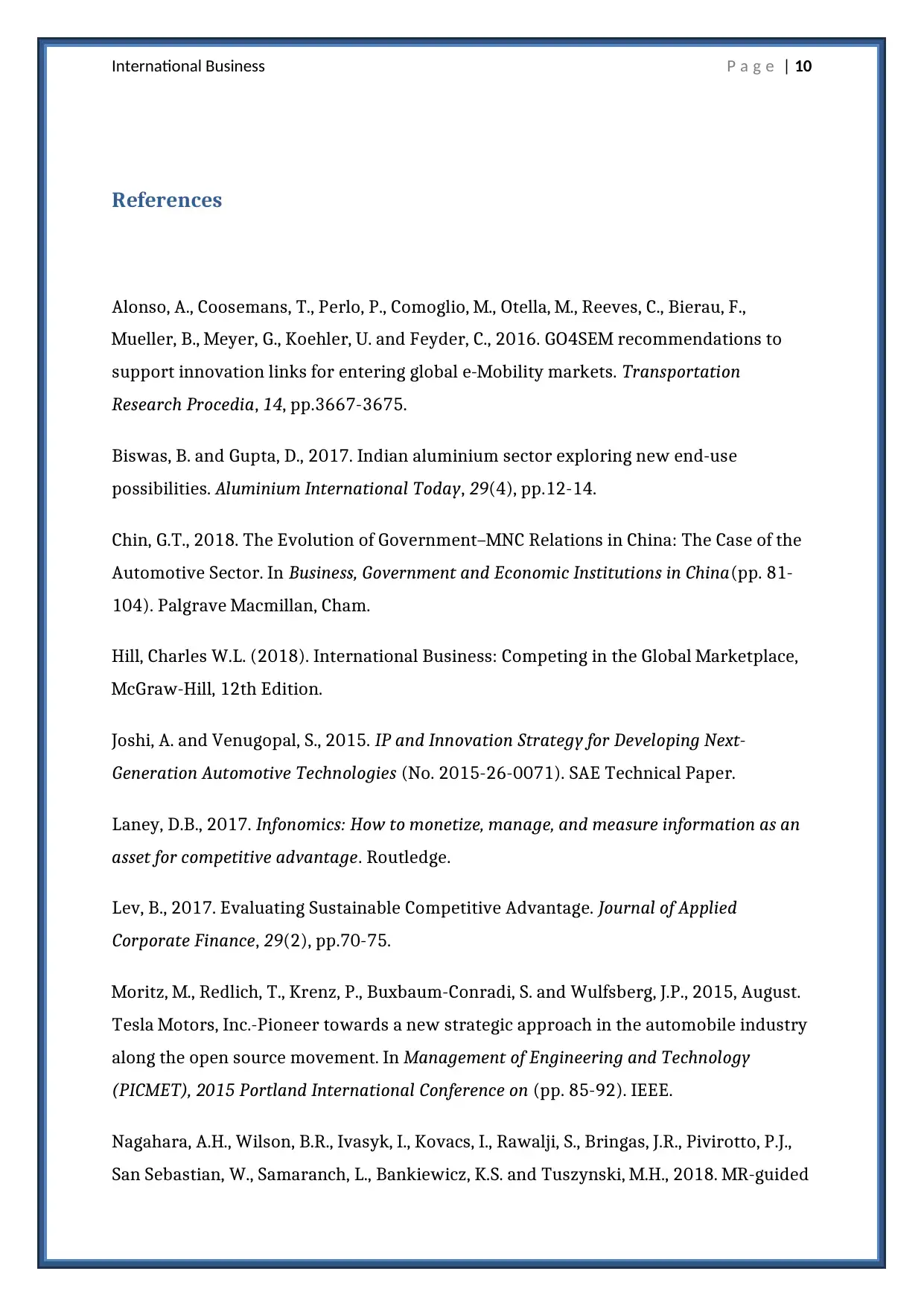
International Business P a g e | 10
References
Alonso, A., Coosemans, T., Perlo, P., Comoglio, M., Otella, M., Reeves, C., Bierau, F.,
Mueller, B., Meyer, G., Koehler, U. and Feyder, C., 2016. GO4SEM recommendations to
support innovation links for entering global e-Mobility markets. Transportation
Research Procedia, 14, pp.3667-3675.
Biswas, B. and Gupta, D., 2017. Indian aluminium sector exploring new end-use
possibilities. Aluminium International Today, 29(4), pp.12-14.
Chin, G.T., 2018. The Evolution of Government–MNC Relations in China: The Case of the
Automotive Sector. In Business, Government and Economic Institutions in China(pp. 81-
104). Palgrave Macmillan, Cham.
Hill, Charles W.L. (2018). International Business: Competing in the Global Marketplace,
McGraw-Hill, 12th Edition.
Joshi, A. and Venugopal, S., 2015. IP and Innovation Strategy for Developing Next-
Generation Automotive Technologies (No. 2015-26-0071). SAE Technical Paper.
Laney, D.B., 2017. Infonomics: How to monetize, manage, and measure information as an
asset for competitive advantage. Routledge.
Lev, B., 2017. Evaluating Sustainable Competitive Advantage. Journal of Applied
Corporate Finance, 29(2), pp.70-75.
Moritz, M., Redlich, T., Krenz, P., Buxbaum-Conradi, S. and Wulfsberg, J.P., 2015, August.
Tesla Motors, Inc.-Pioneer towards a new strategic approach in the automobile industry
along the open source movement. In Management of Engineering and Technology
(PICMET), 2015 Portland International Conference on (pp. 85-92). IEEE.
Nagahara, A.H., Wilson, B.R., Ivasyk, I., Kovacs, I., Rawalji, S., Bringas, J.R., Pivirotto, P.J.,
San Sebastian, W., Samaranch, L., Bankiewicz, K.S. and Tuszynski, M.H., 2018. MR-guided
References
Alonso, A., Coosemans, T., Perlo, P., Comoglio, M., Otella, M., Reeves, C., Bierau, F.,
Mueller, B., Meyer, G., Koehler, U. and Feyder, C., 2016. GO4SEM recommendations to
support innovation links for entering global e-Mobility markets. Transportation
Research Procedia, 14, pp.3667-3675.
Biswas, B. and Gupta, D., 2017. Indian aluminium sector exploring new end-use
possibilities. Aluminium International Today, 29(4), pp.12-14.
Chin, G.T., 2018. The Evolution of Government–MNC Relations in China: The Case of the
Automotive Sector. In Business, Government and Economic Institutions in China(pp. 81-
104). Palgrave Macmillan, Cham.
Hill, Charles W.L. (2018). International Business: Competing in the Global Marketplace,
McGraw-Hill, 12th Edition.
Joshi, A. and Venugopal, S., 2015. IP and Innovation Strategy for Developing Next-
Generation Automotive Technologies (No. 2015-26-0071). SAE Technical Paper.
Laney, D.B., 2017. Infonomics: How to monetize, manage, and measure information as an
asset for competitive advantage. Routledge.
Lev, B., 2017. Evaluating Sustainable Competitive Advantage. Journal of Applied
Corporate Finance, 29(2), pp.70-75.
Moritz, M., Redlich, T., Krenz, P., Buxbaum-Conradi, S. and Wulfsberg, J.P., 2015, August.
Tesla Motors, Inc.-Pioneer towards a new strategic approach in the automobile industry
along the open source movement. In Management of Engineering and Technology
(PICMET), 2015 Portland International Conference on (pp. 85-92). IEEE.
Nagahara, A.H., Wilson, B.R., Ivasyk, I., Kovacs, I., Rawalji, S., Bringas, J.R., Pivirotto, P.J.,
San Sebastian, W., Samaranch, L., Bankiewicz, K.S. and Tuszynski, M.H., 2018. MR-guided
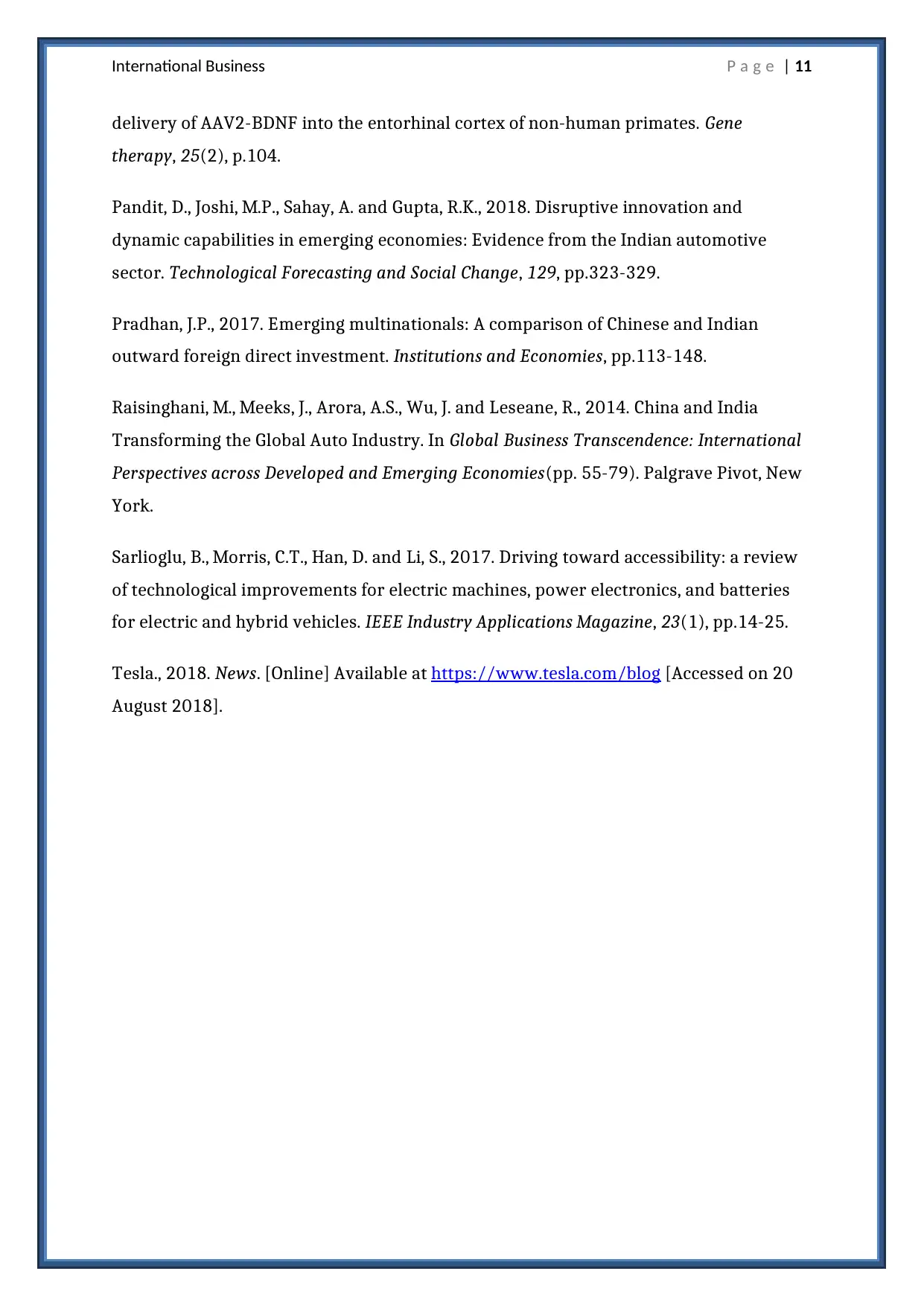
International Business P a g e | 11
delivery of AAV2-BDNF into the entorhinal cortex of non-human primates. Gene
therapy, 25(2), p.104.
Pandit, D., Joshi, M.P., Sahay, A. and Gupta, R.K., 2018. Disruptive innovation and
dynamic capabilities in emerging economies: Evidence from the Indian automotive
sector. Technological Forecasting and Social Change, 129, pp.323-329.
Pradhan, J.P., 2017. Emerging multinationals: A comparison of Chinese and Indian
outward foreign direct investment. Institutions and Economies, pp.113-148.
Raisinghani, M., Meeks, J., Arora, A.S., Wu, J. and Leseane, R., 2014. China and India
Transforming the Global Auto Industry. In Global Business Transcendence: International
Perspectives across Developed and Emerging Economies(pp. 55-79). Palgrave Pivot, New
York.
Sarlioglu, B., Morris, C.T., Han, D. and Li, S., 2017. Driving toward accessibility: a review
of technological improvements for electric machines, power electronics, and batteries
for electric and hybrid vehicles. IEEE Industry Applications Magazine, 23(1), pp.14-25.
Tesla., 2018. News. [Online] Available at https://www.tesla.com/blog [Accessed on 20
August 2018].
delivery of AAV2-BDNF into the entorhinal cortex of non-human primates. Gene
therapy, 25(2), p.104.
Pandit, D., Joshi, M.P., Sahay, A. and Gupta, R.K., 2018. Disruptive innovation and
dynamic capabilities in emerging economies: Evidence from the Indian automotive
sector. Technological Forecasting and Social Change, 129, pp.323-329.
Pradhan, J.P., 2017. Emerging multinationals: A comparison of Chinese and Indian
outward foreign direct investment. Institutions and Economies, pp.113-148.
Raisinghani, M., Meeks, J., Arora, A.S., Wu, J. and Leseane, R., 2014. China and India
Transforming the Global Auto Industry. In Global Business Transcendence: International
Perspectives across Developed and Emerging Economies(pp. 55-79). Palgrave Pivot, New
York.
Sarlioglu, B., Morris, C.T., Han, D. and Li, S., 2017. Driving toward accessibility: a review
of technological improvements for electric machines, power electronics, and batteries
for electric and hybrid vehicles. IEEE Industry Applications Magazine, 23(1), pp.14-25.
Tesla., 2018. News. [Online] Available at https://www.tesla.com/blog [Accessed on 20
August 2018].
⊘ This is a preview!⊘
Do you want full access?
Subscribe today to unlock all pages.

Trusted by 1+ million students worldwide
1 out of 12
Related Documents
Your All-in-One AI-Powered Toolkit for Academic Success.
+13062052269
info@desklib.com
Available 24*7 on WhatsApp / Email
![[object Object]](/_next/static/media/star-bottom.7253800d.svg)
Unlock your academic potential
Copyright © 2020–2026 A2Z Services. All Rights Reserved. Developed and managed by ZUCOL.





